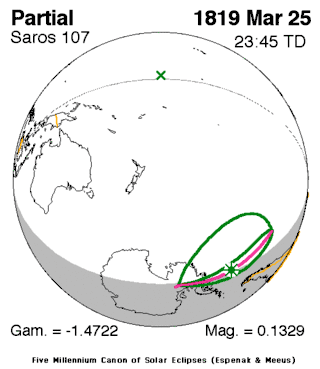Solar eclipse of March 25, 1819
A partial solar eclipse occurred on March 25, 1819 in the first days of fall. A solar eclipse occurs when the Moon passes between Earth and the Sun, thereby totally or partly obscuring the image of the Sun for a viewer on Earth. A partial solar eclipse occurs in the polar regions of the Earth when the center of the Moon's shadow misses the Earth.
| Solar eclipse of March 25, 1819 | |
|---|---|
 Map | |
| Type of eclipse | |
| Nature | Partial |
| Gamma | -1.4722 |
| Magnitude | 0.1329 |
| Maximum eclipse | |
| Coordinates | 61.2°S 87.9°W |
| Times (UTC) | |
| Greatest eclipse | 23:44:30 |
| References | |
| Saros | 107 (71 of 72) |
| Catalog # (SE5000) | 9087 |
It was the first of four partial eclipses that took place that year, each two in two months, the next on was on April 24 covered a part of the Northern Hemisphere.[1] It was the last two of solar saros 107, the last one was on April 5, 1837.[2]
Description
The eclipse was visible in the peninsular portion of Antarctica and a part of the southeastern portion of the Pacific Ocean.
All of the eclipse started at sunset, first in the middle of the peninsular portion of the Antarctic mountains, it finished west of Valparaiso, Chile.
It showed about up to nearly 10% obscurity in Antarctica. The greatest eclipse was halfway between the southern top of the South American mainland and the tip of the middle of the Antarctic Peninsula in the Pacific at 61.2 S, 87.9 W at 23:44 UTC (5:15 PM local time).[1]
The subsolar marking was in the Pacific just north of the Equator.
See also
- List of solar eclipses in the 19th century
- List of solar eclipses visible from Antarctica
References
- "Solar eclipse of March 25, 1819". NASA. Retrieved March 12, 2017.
- "Solar Saros 117". NASA. Retrieved March 12, 2017.
.jpg.webp)

